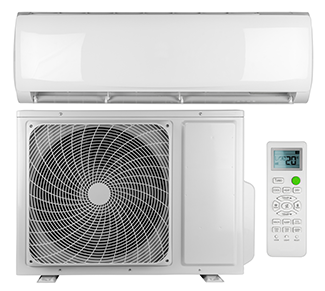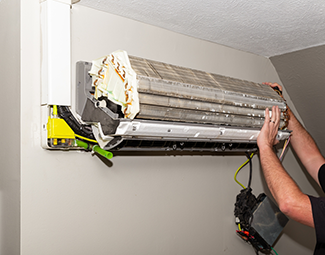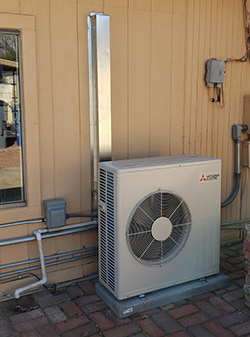How To Maximize The Benefits Of A Mini-Split
Mini-Split Air Conditioner
Mini-Split – kind of sounds like a small ice cream dessert. Well, a mini-split can keep you cool, but you can’t eat it. A mini-split can also keep you warm.
A mini-split, also called a ductless air system, allows you to control the temperature of one room by connecting the outdoor condenser unit and an indoor evaporator/air handler unit without the need for ductwork. The units are connected by small cables and a refrigerant line through a hole in the wall.

It works similar to a window air conditioner, but it is installed on a wall. It is also much quieter and more efficient.
A conventional central A/C system generates cold air at a single point and distributes it through large ducts throughout the home. A mini-split system uses an individual fan and evaporator unit for each room.
The benefit of a mini-split is that you can save energy by not cooling or heating rooms that are not regularly used. Rooms, particularly west-facing ones, can be warmer than other rooms. Rather than crank up the AC, which will make the whole house feel like an icebox, just adjust the mini-split. This system is also available in dual-zone mini splits and tri-zone mini-splits.
There are also systems on the market that include smaller solar panels that can power a mini-split system for a smaller home. Some are still tied to the electric grid for times when the sun stops shining.
Locations where a mini-split is a good option
There are several locations where a mini-split makes sense. The unit must be installed where air can be distributed equally throughout the room. Wall-mounted, indoor units should be placed at least eight to 10 feet from the floor to avoid sending cool air to the ceiling. Keep a clear path for exiting fan air to vent outdoors. The location also needs to be accessible to HVAC technicians.
The Bedroom
If you like a cool room when you sleep, get a mini-split. It will cool just the bedroom and not the rest of the unoccupied house. When installing the unit, make sure that the airflow is not directed to blow on your head.
The Garage
If you use the garage as a gym, hobby shop, or band practice, a mini-split will allow you to use the space year-round.
A Home Office

Between the computer, printer, and lamp, the heat generated in a home office can get toasty. A unit in that room will keep you comfortable all day so you can focus on your work.
Sunroom
Sunrooms can be a challenge to keep cool in the summer and warm in the winter because they’re often converted porches and patios that do not have the ductwork necessary to connect to your home’s HVAC system.
Doghouse
For multiple dogs that need a doghouse substantially larger than Snoopy's, a mini-split will keep them comfortable during every season.
Before You Buy
Before you invest in a mini-split, Trane suggests that you consider these questions:
- How often will you be running this unit?
- Do you need heating, cooling, or both?
- What premium and value brand options are out there?
- What’s the size of the space you need to heat/cool?
Then ask the dealer these questions:
- How long have they been installing ductless systems, and when was the last time they were trained on this product?
- What is the operating cost?
- Where was the product manufactured, and how easy is it to use?
- How can you troubleshoot or solve problems after the installation?
Maintaining Your Mini-Split
Once you install the unit, it is important to keep it in good condition with regular maintenance that you can do yourself. Cleaning the filters is key to efficient cooling and maintaining an ample supply of clean, breathable air.
The indoor unit

Most systems have an array of filters. The main filters remove large, particulate matter from the air. Those that have HEPA filters, are situated behind the main ones and deal with microscopic particles and microorganisms, such as mold spores and pollen.
The air will not be as well filtered as through paper pleated filters in your HVAC system. For well filtered air, you need to consider a standalone HEPA filter.
Because dirt, debris, and mold can accumulate quickly, REEis, a Rosie-Certified Partner, suggests checking the mini-split filters every two weeks to see if they need cleaning.
To clean mini-split filters, power down the entire system. Let everything cool down. When it is cool, take off the panel of the unit. Wipe away dust with a cloth.
Then remove the filter. With warm water and dish soap, clean both sides of the filter. Rinse off soap residue and put the filter in the shade to air dry. When it is completely dry, place it back in the unit.
The Outdoor Unit
The outdoor unit generates heat. The heat can’t escape if the system is gunked up.
Clean the fins on the housing grate with a damp rag. If you spray them with high-pressure water from a garden hose, the fins can be damaged.

Open the cover to expose the pump and coils. Remove dust with a wet/dry vacuum or with a leaf blower.
Deep-clean the coils periodically by washing them with a hose and needle sprayer nozzle specifically designed for cleaning condenser coils. You can also use the jet function on a conventional multi-setting nozzle.
Turn the fan blades to make sure the fan is secure and balanced. If the fan has any lateral movement, have it serviced by an HVAC professional.
Pro Tip: Read the owner's manual before cleaning the unit. Some systems use negative ion generators and other technologies for purifying the air and may have a different cleaning procedure. It should also mention any extra service it may need.
Other Considerations
Most mini-split systems come with a remote. Always keep fresh batteries handy if the remote conks out. Next, make sure that the unit is plugged in and the outlet has power. Sometimes the cause of a power failure in one room is a tripped GFCI outlet in another room, and sometimes it's a tripped circuit breaker in the main service panel.
If the unit is blowing hot air instead of cold, check the compressor to ensure it is running.
If an error code is on the LED display, consult the owner’s manual or the manufacturer's website.
When in doubt, whether getting ready to purchase a unit, need to maintain one, or have other issues, call the dealer.
Keep in mind that mini-splits are much more efficient than a central heating and cooling system and very affordable to operate.
Home Maintenance To-Do | #MiniSplit
# # #
Podcast
Tune-in & learn about the benefits of cooling your space with Mini Split air conditioning. Plus we answer homeowner questions on elastomeric painting a foam room as a do it yourself project, screened holes under the eaves of a home, exhaust fans code in a new home build, and can you backwash a pool with the sewer cleanout located on the side of a home.
Photo Credit:
- Rosie on the House
- Shutterstock
Related Content
- Blog: What Is A Mini-Split And What Are The Benefits?
- DIY FAQ: Consumer Guide For Buying A Home A/C System
- Podcast: Mini-Splits Air Conditioning
- Consume Guide: Download AC Consumer Guide PDF
- Other: Hunker
